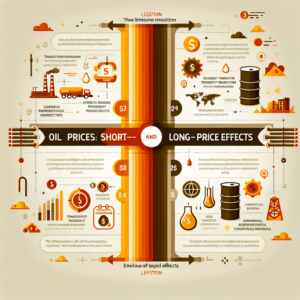
Oil Price Surge Amid OPEC+ Decision
In a significant move for the global energy market, oil prices have surged as the Organization of the Petroleum Exporting Countries (OPEC+) announced a delay in its planned production increase. This decision, which would have seen a gradual ramp-up in oil output, is expected to have far-reaching implications for both consumers and the broader energy sector.
Oil prices are highly sensitive to shifts in supply, and OPEC+’s decision to withhold the planned increase in production has caused both short-term and long-term ripple effects. As oil prices climb, the global economy, particularly the energy-consuming nations, must adapt to these changes, which may include higher fuel costs and supply chain disruptions. In this article, we explore the reasoning behind OPEC+’s decision, its immediate effects on oil prices, and what this means for the energy landscape going forward.
OPEC+ Delays Production Increase: A Strategic Move
The decision by OPEC+ to delay the planned production increase stems from a complex mix of factors affecting the global oil market. At its core, OPEC+ aims to balance the supply and demand equation, preventing an oversupply of crude oil that could destabilize prices. This careful management is crucial as countries, particularly in Europe and Asia, begin to recover from the effects of the COVID-19 pandemic.
While the global economy is slowly rebounding, demand for oil has been fluctuating, with some regions recovering faster than others. This uneven recovery, paired with geopolitical uncertainties and varying domestic policies on energy production, created the perfect storm for OPEC+ to reevaluate its production plans. By delaying the production increase, OPEC+ aims to avoid a situation where global supply outstrips demand, which would likely lead to falling prices.
Furthermore, OPEC+ is responding to potential risks such as the uncertain demand from major oil-consuming countries like China and India. These nations have been significant drivers of oil demand in recent years, but their energy consumption rates remain unpredictable due to factors like economic slowdowns and shifting energy policies.
The delay in production increase also comes as OPEC+ seeks to maintain its influence over the oil market. By managing supply, the alliance can exert greater control over prices, ensuring they stay within a profitable range for its member countries. This careful balancing act reflects the ongoing tension between maintaining market stability and accommodating the needs of global consumers.
Oil Prices Surge: Market Reactions and Predictions
The immediate reaction to OPEC+’s decision was a noticeable increase in oil prices. Within days, both benchmark West Texas Intermediate (WTI) and Brent crude oil prices saw a surge. This is not an unusual response to news of restricted supply, as oil traders often react swiftly to any signals that could affect the availability of crude oil in the market.
The price surge is a direct result of OPEC+’s decision to keep production levels stable. The market, which had expected a gradual increase in supply, found itself facing potential supply shortages. This shift in market expectations led to a rise in futures contracts, with oil traders betting that prices would climb in the short term.
Experts predict that this surge in prices may not be short-lived. If global demand continues to rise as expected, especially with major economic players like China recovering, OPEC+ may find itself in a position where it must increase production more rapidly. However, the timing and scale of any future production hikes will depend on how the global economy evolves and how OPEC+ chooses to balance its strategic interests with market realities.
Oil price fluctuations are also closely tied to the strength of the U.S. dollar, as oil is typically traded in dollars on the global market. A weaker dollar can make oil cheaper for foreign buyers, further driving up demand and pushing prices higher. As geopolitical uncertainties—such as tensions in the Middle East—continue to shape oil markets, oil prices could continue to experience volatility.
Why OPEC+ Decided to Delay Production Increase
OPEC+’s decision to delay the planned production increase is based on several factors, each of which influences global oil supply and prices. The primary reasons for this delay are:
-
Oversupply Concerns: One of the primary reasons for the delay is the fear of oversupply. If OPEC+ had gone ahead with the production increase, there would have been a risk of oversupply in the market, especially if demand from major consumer countries like China or the European Union does not rise at the anticipated rate. An oversupply could have resulted in a drop in prices, which would negatively impact OPEC+ member economies that rely heavily on oil exports.
-
Global Economic Uncertainty: Despite positive signs of recovery from the pandemic, the global economic situation remains unpredictable. OPEC+ is particularly cautious about the impact of inflation and rising interest rates in major economies. These economic factors could dampen consumer spending and slow down industrial activity, both of which would reduce oil demand.
-
Geopolitical Tensions: Tensions in the Middle East and other key oil-producing regions have also played a role in OPEC+’s decision. Geopolitical instability often results in fluctuations in oil supply, and OPEC+ may be trying to mitigate any future supply disruptions by carefully managing production rates.
-
China’s Economic Recovery: China’s recovery from the pandemic is a key variable in determining oil demand. While China has been ramping up industrial production, it is unclear whether its demand for oil will continue to rise at the same pace as it did before the pandemic. OPEC+ is taking a cautious approach, waiting to see whether China’s demand will stabilize or continue to grow.
-
Environmental and Policy Shifts: Many countries are transitioning toward renewable energy sources, and OPEC+ must also consider the longer-term implications of the global shift away from fossil fuels. While the demand for oil is still strong, particularly in emerging economies, the global energy transition could dampen oil consumption in the future, influencing OPEC+’s long-term strategies.
Oil Prices Surge: Short-Term and Long-Term Effects
The impact of OPEC+’s decision extends beyond just a temporary rise in oil prices. The immediate effects are clear: consumers are facing higher fuel prices, and industries that rely heavily on oil are seeing increased operational costs. However, there are also broader implications for the global economy.
Short-Term Effects
In the short term, rising oil prices tend to increase the cost of living for consumers. Higher fuel prices lead to increased transportation costs, which, in turn, raise the prices of goods and services. This inflationary pressure can have a knock-on effect on various industries, including manufacturing, transportation, and even food production, as the cost of raw materials and logistics rises.
Moreover, countries that are net oil importers will face higher energy costs, which can strain their economies and reduce disposable income for consumers. Conversely, oil-exporting nations, many of which are members of OPEC+, will benefit from the price surge, as it increases their revenue from oil exports.
Long-Term Outlook
The long-term outlook for oil prices is less certain. While the OPEC+ decision to delay the production increase may help stabilize prices for now, the broader trend of increasing demand—particularly from countries like China and India—will likely put upward pressure on prices in the coming years. Additionally, if geopolitical tensions escalate or major supply disruptions occur, oil prices could experience significant volatility.
Over time, OPEC+ may need to make further adjustments to its production strategies based on these factors. If oil demand continues to rise, OPEC+ may find itself forced to increase production at a faster pace than originally planned, which could lead to lower prices in the future as supply meets demand.
How Consumers Are Affected by Rising Oil Prices
The immediate effect of rising oil prices is felt most acutely by consumers. As fuel prices rise, people see their cost of living increase, with transportation and heating costs becoming more burdensome. These increased costs often lead to inflationary pressures in other areas of the economy, as businesses pass on higher operational costs to consumers in the form of higher prices.
Higher oil prices also have a significant impact on industries that rely heavily on transportation, such as logistics, airlines, and freight services. Companies in these sectors may find it necessary to raise prices or reduce services to maintain profitability. For consumers, this means the possibility of higher ticket prices for flights, increased shipping costs for goods, and an overall rise in the cost of products that rely on transportation.
A Wait-and-See Approach for Oil Markets
OPEC+’s decision to delay the planned production increase has had immediate consequences on oil prices, with a rise in costs for consumers and industries worldwide. While this decision offers some stability in the short term, the long-term outlook remains uncertain. As geopolitical risks, economic recovery rates, and consumer demand continue to evolve, OPEC+ will need to make further adjustments to its production strategy.
As oil prices continue to fluctuate, both consumers and businesses will need to stay informed about these developments. The energy transition, changes in global demand, and political factors will continue to influence the direction of oil prices, making it essential to track OPEC+’s moves and the broader economic landscape closely.
Visit our other website: https://synergypublish.com


